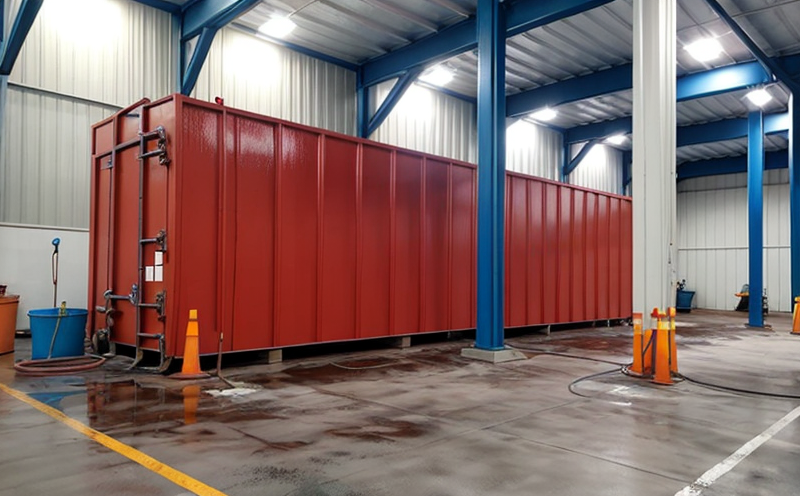ASTM D4541 Pull Off Strength Testing of Coatings Precision and Accuracy Evaluation Test
The ASTM D4541 standard is a widely recognized method used to evaluate the adhesion strength between coatings and substrates. This test is essential for quality control, ensuring that coatings are not only applied correctly but also adhere effectively to prevent potential failure points in industrial manufacturing processes.
ASTM D4541 involves the use of a pull-off tester to measure the cohesive and adhesive properties of coatings. During this process, small samples (typically 25 mm diameter) are prepared by adhering a coating to a substrate. Specimens are then subjected to a tensile force until separation occurs, either within the coating or at its interface with the substrate.
The precision and accuracy of ASTM D4541 testing are critical for ensuring reliable results that can be used in quality assurance and product development processes. This test is particularly important in industries where coatings play a vital role in protecting materials from environmental factors such as moisture, chemicals, or mechanical stress.
In industrial manufacturing, the selection of appropriate adhesion levels ensures that coatings withstand the rigors of various environments without compromising on their protective capabilities. For instance, in aerospace applications, high adhesion strength is crucial to prevent coating delamination under harsh atmospheric conditions. In contrast, in automotive manufacturing, it's equally important for ensuring durability and longevity against road salt and UV exposure.
The ASTM D4541 method provides a standardized approach to measuring the pull-off strength of coatings, which helps manufacturers and regulators compare results across different materials or batches consistently. This ensures that all parties involved have confidence in the accuracy of the test data. The procedure involves several key steps including sample preparation, application of force, measurement, and calculation.
For quality managers and compliance officers, understanding ASTM D4541 is essential to ensure adherence to industry standards and regulatory requirements. R&D engineers can leverage this knowledge to innovate new coating formulations that meet or exceed current adhesion strength expectations. Additionally, procurement teams must verify that suppliers provide coatings with the necessary pull-off strengths to satisfy end-user specifications.
The ASTM D4541 standard is particularly relevant for industrial manufacturing processes where coatings are used in harsh environments, such as those found in chemical processing plants, oil refineries, and offshore drilling platforms. In these sectors, ensuring that coatings adhere well can significantly extend the service life of equipment while reducing maintenance costs.
By adhering to ASTM D4541 guidelines, laboratories and testing facilities ensure consistent and accurate results when evaluating coating adhesion strength. This consistency is crucial for maintaining high-quality standards across diverse manufacturing environments. The precision and accuracy provided by this test help manufacturers make informed decisions about their coating choices, ultimately leading to safer, more reliable products.
Understanding the ASTM D4541 standard allows stakeholders in industrial manufacturing to optimize their processes, enhance product performance, and comply with relevant regulations. Proper implementation of this testing method contributes significantly to maintaining robust quality assurance practices within organizations operating across various sectors.
Scope and Methodology
ASTM D4541 specifies the procedure for determining the adhesion strength of coatings using a pull-off tester. This test measures both cohesive and adhesive properties by subjecting coated specimens to tensile forces until separation occurs.
- Specimen Preparation: Small circular specimens (typically 25 mm diameter) are prepared by adhering the coating sample onto a suitable substrate such as steel or aluminum. The area around the bond line should be carefully cleaned and degreased to ensure proper adhesion.
- Tensile Force Application: Once the specimen is ready, it undergoes application of force using specialized equipment designed for ASTM D4541 tests. This machine applies a controlled tensile load until failure occurs.
- Data Collection: Upon reaching maximum stress points before separation, data on peak force and displacement are recorded. These values help calculate the cohesive strength within the coating itself as well as adhesive properties at the interface between the coating and substrate.
The methodology ensures that all tests conducted follow identical procedures, thereby enhancing comparability among different studies or laboratories worldwide. Compliance with ASTM D4541 helps maintain consistent quality standards across various industries relying heavily on coatings for protection against environmental hazards.
Frequently Asked Questions
International Acceptance and Recognition
The ASTM D4541 pull-off strength test is widely recognized internationally for its reliability in assessing coating adhesion performance. It has been adopted by numerous organizations globally, including national standards bodies such as the British Standards Institution (BSI) and European Committee for Standardization (CEN).
- ISO: While ISO does not have a direct equivalent to ASTM D4541, its standards often align closely with ASTM practices.
- IEC: The International Electrotechnical Commission also recognizes the importance of adhesion testing methods like those specified in ASTM D4541 for ensuring product quality and safety.
- CEN: European standards bodies frequently reference or incorporate aspects similar to ASTM D4541 when developing their own guidelines on coating performance.
The widespread acceptance of ASTM D4541 in global markets underscores its significance as a benchmark for ensuring consistent and high-quality results. Compliance with this standard is increasingly seen as essential for companies operating internationally, enabling them to meet diverse regulatory requirements across different countries.
Use Cases and Application Examples
ASTM D4541 pull-off strength testing finds application in various sectors where coatings play a critical role. Here are some key use cases:
- Aerospace Industry: Ensuring that protective coatings on aircraft surfaces adhere well to withstand atmospheric conditions.
- Automotive Manufacturing: Verifying coating adhesion for vehicle body panels exposed to salt spray and UV radiation.
- Petrochemical Plants: Confirming the durability of coatings used in pipelines and storage tanks against harsh chemical environments.
- Offshore Oil Platforms: Evaluating protective layers on drilling equipment subjected to marine conditions.
In each case, the precision and accuracy provided by ASTM D4541 help manufacturers ensure that their products meet stringent quality standards. This contributes significantly to enhancing overall product reliability and safety in demanding industrial settings.





